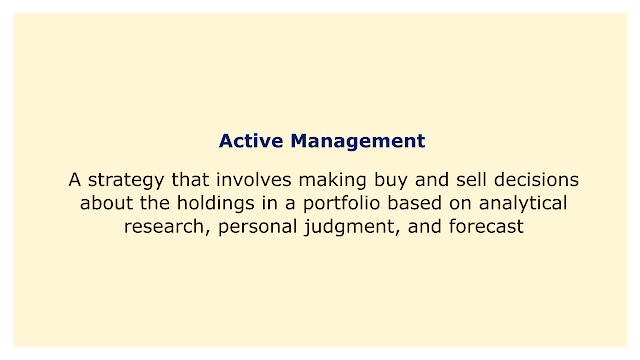 |
| Image: Moneybestpal.com |
Active management is a strategy that involves making buy and sell decisions about the holdings in a portfolio based on analytical research, personal judgment, and forecasts. Active managers seek to outperform a benchmark by spotting mispriced assets and taking advantage of market inefficiencies.
The benchmark is typically some kind of market index. In addition to managing risk, active management aims to boost profits or meet other investor objectives, such as executing a sustainable investment strategy.
The opposite of active management is passive management, which employs straightforward guidelines to mimic an index or other benchmark in an effort to track it. Long-term performance against the market, according to passive managers, is unachievable because stock prices have already factored in all available information. Additionally, passive managers claim that active managers exhibit human biases and mistakes that result in subpar performance. Moreover, passive management has lower costs than active management.
The active management method typically consists of three steps: planning, execution, and feedback. Active managers determine the investor's goals and limitations in the planning stage, including anticipated risk and return, liquidity requirements, time horizon, tax implications, and statutory and regulatory requirements. An investment policy statement (IPS), which describes the reporting requirements, rebalancing criteria, investment communication, management fees, and investment strategy and style, can be formed from these objectives and restrictions. Active managers then create a capital market expectation and anticipate the risk and return characteristics of the assets that will serve as the foundation of the portfolio. Last but not least, asset class weights are used to calculate the strategic asset allocation.
Active management has its difficulties and disadvantages. Active managers compete fiercely with other market players who are also looking to take advantage of market inefficiencies. Because to increased trading activity, greater research costs, and higher management fees, active managers also have higher costs than passive managers. Active managers must also cope with behavioral problems including herd mentality, confirmation bias, overconfidence, loss aversion, and confirmation bias that might influence their decision-making.
The process of active management is dynamic and complex, requiring expertise, knowledge, experience, and discipline. Market conditions need to be continuously monitored by active management, who must then modify their tactics as necessary. Also, excellent communication regarding performance and expectations with clients and other stakeholders is a requirement for active managers. Investors seeking higher returns or specific objectives that passive management is unable to deliver may find advantages in active management.
The opposite of active management is passive management, which employs straightforward guidelines to mimic an index or other benchmark in an effort to track it. Long-term performance against the market, according to passive managers, is unachievable because stock prices have already factored in all available information. Additionally, passive managers claim that active managers exhibit human biases and mistakes that result in subpar performance. Moreover, passive management has lower costs than active management.
The active management method typically consists of three steps: planning, execution, and feedback. Active managers determine the investor's goals and limitations in the planning stage, including anticipated risk and return, liquidity requirements, time horizon, tax implications, and statutory and regulatory requirements. An investment policy statement (IPS), which describes the reporting requirements, rebalancing criteria, investment communication, management fees, and investment strategy and style, can be formed from these objectives and restrictions. Active managers then create a capital market expectation and anticipate the risk and return characteristics of the assets that will serve as the foundation of the portfolio. Last but not least, asset class weights are used to calculate the strategic asset allocation.
Active managers carry out the portfolio's construction and adjustment during the execution phase. Active managers choose particular assets for the whole portfolio by integrating their investment strategy with expectations from the capital markets. By effectively combining assets to achieve specific return and risk goals, active managers optimize the portfolio in this way.
In the feedback step, active managers control investment exposures by rebalancing the portfolio to make sure it still falls under the purview of the IPS. Investors also review the performance of the portfolio on a regular basis to make sure that investment goals are being reached.
Active management has its difficulties and disadvantages. Active managers compete fiercely with other market players who are also looking to take advantage of market inefficiencies. Because to increased trading activity, greater research costs, and higher management fees, active managers also have higher costs than passive managers. Active managers must also cope with behavioral problems including herd mentality, confirmation bias, overconfidence, loss aversion, and confirmation bias that might influence their decision-making.
The process of active management is dynamic and complex, requiring expertise, knowledge, experience, and discipline. Market conditions need to be continuously monitored by active management, who must then modify their tactics as necessary. Also, excellent communication regarding performance and expectations with clients and other stakeholders is a requirement for active managers. Investors seeking higher returns or specific objectives that passive management is unable to deliver may find advantages in active management.
